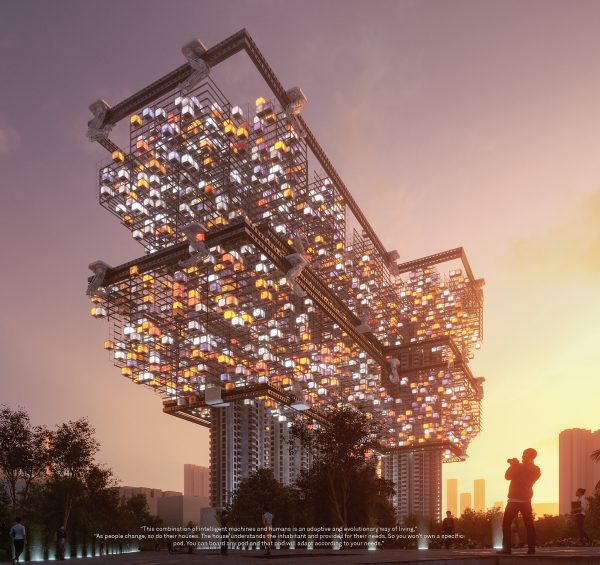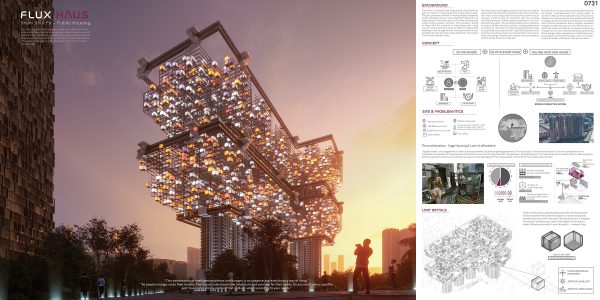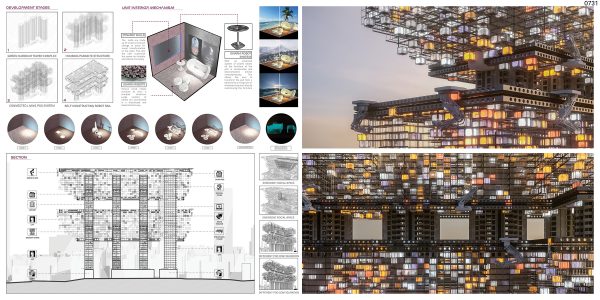Editors’ Choice
2020 Skyscraper Competition
Jitendra Shrawan Farkade
India
Flux Haus is a parasitic housing scheme, that would engulf five towers in Hong Kong with single-person pods. The grid structure covered in moving single-occupancy pods is designed to be a “more dignified” alternative to cage homes – tiny dwellings enclosed by a gridded metal walls and large enough for only one bunk bed. It would be built on another building that would contain support facilities, in this case, a housing complex in the Sham Shui Po district in Hong Kong. Given current socio-economic conditions and how they spill into Hong Kong’s housing disparity, it offers a futuristic response to inadequate and undignified living conditions.
The proposal is based in Sham Shui Po, a district in Hong Kong with a high cost of living that forces locals to settle in substandard dwellings such as cage houses. A look into Hong Kong’s cage homes gives us a glimpse of how bad the problem of land scarcity is already. Hong Kong has been ranked the least affordable city nine years in a row.
This project is an attempt to use AI and technology to solve the problem of space scarcity. This combination of intelligent machines and humans is an adaptive and evolutionary way of living. As people change, so do their houses. The house understands the inhabitant and provides for their needs. So you won’t own a specific pod. You can board any pod and that pod will adapt according to your needs.
Each pod would be suspended from the grid that would encompass the five towers in the Green Harbour Tower complex. This structure is envisaged as a grid of metal rails. As part of the proposal, the existing building will be adapted to contain all the communal spaces, including bathrooms and kitchens. The pods will then be programmed to take occupants to these spaces when required. Robotic arms would allow for a self-constructing system through an ever-growing rail system that adapts to the population of the housing complex. As a result, the grid structure would autonomously expand over time. Along with this, Flux House’s AI system would also determine the movements of the pods, finding free spaces to dock them and arrange the pods to create communal spaces. This system would create an ever-changing environment adapting to varying conditions and requirements.
Flux Haus cubic living-pods all measure just over7.5 square meters. Dwellers would access the structure from the existing building entrances, before being transported to an available docking space. Each pod would have the same basic layout, but incorporate AI and swarm robot technology. Swarm robotics is the coordination of large numbers of simple physical robots to carry out a desired collective behavior, modeled on the biological studies of insects. These swarm robots will work together to construct the desired room layout and furniture instantly, enabling the cubes to be transformed from a living or dining room to a bedroom instantly.
With an advanced system of swarm robots, all the furniture of the pod is constructed and deconstructed almost instantaneously. This allows users to transform the pod from a bedroom to a living room or whatever by customizing to their preferences based on digital assets that they buy. Each pod is complete with artificial ventilation and a sunlight simulator, designed so that the pods do not need windows. Instead, the walls are made up of screens that can be changed to form any desired backdrop. Collectively, these designs allow occupants to comfortably occupy any space within the Flux Haus, and in turn, maximize the number of inhabitants that can live there.

















